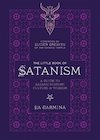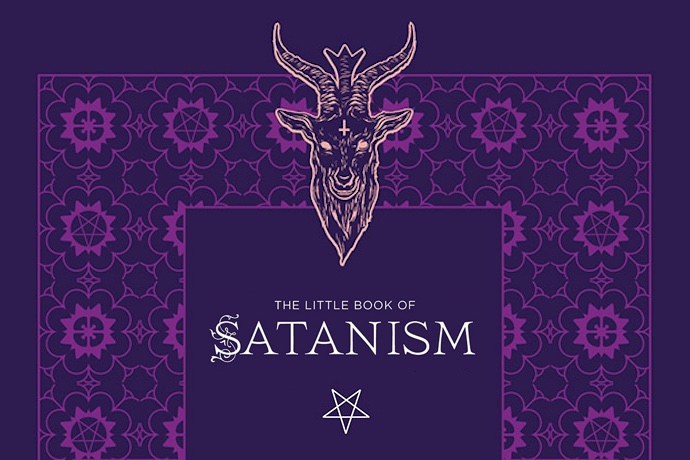For most of its existence, religious Satanism has been regarded as either unfit for polite conversation or fodder for sensationalist tabloid media. In the 1990s, Anton LaVey complained,
“Whenever I got on TV or the radio, I was given a few seconds to say what they desperately needed me for. Someone else who had lost 240 pounds of ugly fat got 20 minutes of air time. A woman who saw Jesus on a tortilla had even more time to recount her experience. If Satanism was so hot, why wasn’t I able to talk about it?”
Likewise, religious studies has been guilty of covertly relegating Satanism to a “second-tier” of religions, far beneath Christianity and other “world religions.” In fact, talking about Satanism made some religious studies scholars uncomfortable precisely because its existence called the “world religions paradigm” into question and exposed the barriers erected to maintain this category.

The Little Book of Satanism: A Guide to Satanic History, Culture, and Wisdom
La Carmina
Ulysses Press
October 25, 2022
RD recently spoke with La Carmina about the connection between QAnon and Satanic Panic, Satanists’ support for LGBTQ rights, and the Devil’s ever-deepening hoofprint on pop culture.
This interview has been edited for length and clarity.
Satanism appears to be having a moment right now, not only in terms of religion, but also in pop culture and politics. Why do you think this is?
I’d point to the rise of social media and the Internet, which facilitated the spread of ideas and allowed Satanists worldwide to connect and organize. The Satanic Temple’s establishment in 2013 also helped spur a new movement of politically and socially engaged Satanism, and shape conversations about Satanism as a religion. I think the pop culture factor is a continuation of the Devil’s ever-deepening hoofprint on music, movies, and literature starting in the 1960s (I discuss Rosemary’s Baby and other works in my book). To me, all these elements suggest that Satanism will keep on growing in influence over the next decades.
One of the fascinating episodes covered in your book that will be unfamiliar to most American readers is the so-called “Affair of the Poisons” in 17th century France. Can you briefly explain what this was and whether you think it was a case of actual Satanism?
In the late 17th century, dozens of women working on the fringes of Parisian society as fortune tellers, soothsayers and abortionists were accused of engaging in Satanism. King Louis XIV established a special court to judge them in what became known as the Affair of the Poisons—as they were accused of selling deadly elixirs along with sacrificing babies and performing Black Masses!
It’s hard to separate fact and fiction in centuries-old accounts, but from my research, there appears to be some evidence that the accused dabbled in “sex magic and necromancy rituals that veered on the side of diabolism,” as I put it in my book.
I think the most interesting aspect of the Affair is that—similar to the European and American witch trials—those put to death for “practicing Satanism” were women who were relegated to the margins of society (some were LGBTQ, while others provided secret abortions). Looking at the history of Satanism, it makes sense that many Satanists today are standing up for reproductive, LGBTQ and minority rights.
Can you talk about the role of movies like Rosemary’s Baby and The Exorcist in shaping the Satanic Panic that peaked in the 1980s?
These horror novels and movies were extremely popular, and brought forth the idea that Devil-worshippers were lurking in your neighborhood and plotting to steal your children. This frightening conceptualization of Satanists took over the popular imagination, and dovetailed with increasing social unease about the dissolution of the nuclear family. These factors (along with others, such as the publication of Michelle Remembers) spiraled into the Satanic Panic of the 1980s and 1990s. A wave of hysteria arose over Satanists allegedly infiltrating preschools and engaging in horrific acts like blood sacrifices and ritual abuse. Farfetched as these claims sound now, they had real and tragic consequences: people were unjustly accused and jailed for committing crimes in the name of Satan.
Shows like Stranger Things suggest Satanic Panic was just a phenomenon of the 1980s—like slap bracelets or shoulder pads. But you connect contemporary phenomena like QAnon to Satanic Panic. How is QAnon different from what we saw in the 1980s? And do you think conspiracy theories like this will ever go away?
Although daytime TV exposés about teenage Devil-worshippers died down after the 1990s, the Satanic Panic certainly didn’t end. Today, we see these ideas take on new life with QAnon falsehoods that link Satanism to political conspiracies such as Pizzagate (Democrats engaging in Satanic ritual abuse in a DC pizza parlor) and adrenochrome-harvesting. Of course, social media and the Internet have amplified these contemporary conspiracy theories. When I see the effects of fake news on people I know—coupled with an ever-increasing lack of critical thinking—I’m pessimistic about this rhetoric ever dying down.
[Editor’s note: For more on this connection, read David Frankfurter’s 2020 piece, What Does Satanism Have to do With QAnon?]
Religious studies often frame religious Satanism as beginning in 1966 with Anton LaVey and the Church of Satan. But your book mentions several significant groups and figures that predate LaVey. Can you talk about some of these groups and whether or not they should count as Satanists?
Indeed, most scholars consider the Church of Satan (est. 1966) to be the first modern Satanic religion. However, there were some late 19th and early 20th century religious groups that perceived Satan as a positive figure (i.e., a light-bringer of knowledge and rationality) and incorporated him into their spiritual ideas. These include The Theosophical Society, Fraternitas Saturni, and a few figures who self-identified as Satanists, such as Polish writer Stanisław Przybyszewski. I’d consider these precursors to be important to the development of modern Satanism, as they mark “the first instances of individuals calling themselves Satanists, and holding Satanic religious values supported by some degree of organization.”
The rivalry between The Church of Satan and The Satanic Temple can present an obstacle to researchers. What do you see as the most important differences between these groups?
The foundational basis is quite different, as The Satanic Temple takes inspiration from Romantic Satanism (the early to mid-19th century literary movement that re-cast the Devil as a courageous rebel against arbitrary authority), and the novel Revolt of the Angels (which says a violent overthrow of God is not the answer, as it only installs a new tyrant).
[Church of Satan founder] Anton LaVey’s The Satanic Bible has significant influences from Ayn Rand’s Objectivism (with the goals of happiness and reason) and Friedrich Nietzsche’s philosophies on self-realization, as well as Ragnar Redbeard’s Might is Right. His writings emphasize pursuing one’s self-interest and staying out of politics, which contrast with TST’s humanistic values of compassion and engaging in socio-political activism.
My book goes into greater detail about the two organizations’ central convictions, development, and leading roles in modern Satanism.
Your past projects have included a cookbook and a book on Tokyo theme restaurants. How did you first become interested in Satanism?
I was an early adopter of blogging, having started my La Carmina Blog in 2007. My readers particularly loved my firsthand reports of Japanese offbeat culture, which led to my first books Cute Yummy Time and Crazy, Wacky Theme Restaurants: Tokyo. During these early blogging days, I spent a great deal of time in Japan and was introduced to Japanese Satanists and their fascinating practices. I loved getting to know the small but vibrant Satanic communities in Tokyo, Osaka and Kobe.
Over the years, I kept investigating and writing about Satanism worldwide for my site and various publications such as Fodor’s (profile of The Satanic Chef), The Daily Beast (Satanic travel destinations), and Inkstick (The Satanic Temple’s reproductive rights campaigns)—which led to a book deal for The Little Book of Satanism.
I’m not aware of any scholarship on Satanism in Japan, other than what’s discussed in your book. Did you notice Satanism on your travels in Japan? Why would a country that’s never experienced Christian hegemony find Satanism interesting?
I’ve long been participating in and reporting on Japanese Satanism. The religion has a small but earnest following in Japan, and it takes on a different expression because of the cultural background. Only around one percent of Japanese identify as Christian, so locals don’t grow up with the fundamentalist influences or Biblical narratives that are omnipresent in countries like the US.
However, Japanese society is notoriously conservative and conformist. In this context, Satanists find meaning and motivation in the idea of Lucifer as an authority-questioning rebel. Wearing an inverted cross or 666 won’t raise eyebrows in Japan (as these aren’t considered blasphemous symbols by most residents). But pursuing one’s fullest self-expression is a radical idea in a collective-minded country.
What’s your next project? Where do you go after this?
I just returned from Japan—it was my first time back in three years, and I’m relieved that the country is open to unrestricted tourism again. Next, I’m heading to Medellin, Colombia on a food and travel journalism project. For the time being, I’m focusing on the release of The Little Book of Satanism: A Guide to Satanic History, Culture & Wisdom. I hope my short guidebook can help people understand the roots of religious Satanism, and put to rest the many misguided ideas about Satanists and their practices. As always, I’ll be sharing updates from my Satanic escapades worldwide on my social media @LaCarmina and website www.lacarmina.com.





